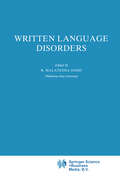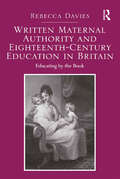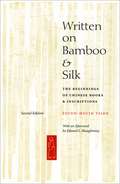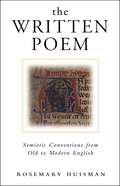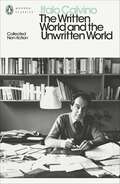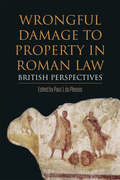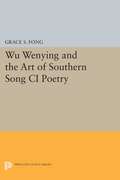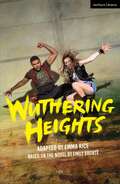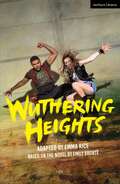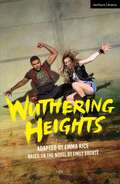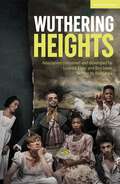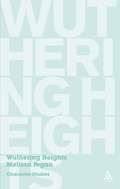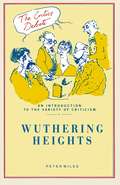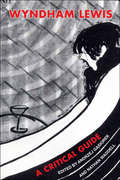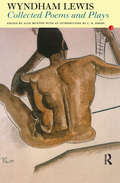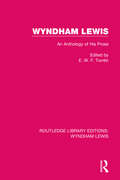- Table View
- List View
Written Language Disorders (Neuropsychology and Cognition #2)
by R. MalateshaJoshiAlthough anecdotal reports of loss of once-acquired reading ability was noticed in the individuals who had sustained brain damage as early as the year AD. 30, systematic enquires of alexia were not undertaken until the latter part of the nineteenth century. The two anatomo-pathological studies carried out by Dejerine in 1891 and 1892 mark the beginning of scholarly investigation of reading failure. Interestingly, the study of de velopmental reading disability also began to receive attention at about the same time when Pringle Morgan described the case of a 14-year-old boy who had great difficulty in reading and writing. Since then sporadic reports of developmental reading-writing failure began to appear in medi cal and educational journals even though such investigation went on at an unhurried pace. In the past two decades, however, the situation has changed enormously and hundreds of articles that have investigated developmental and acquired cognitive disabilities have been published. Disorders of spoken language and written language are two areas that have been extensively addressed by these articles. Those who study disorders of language come from a wide variety of backgrounds and their reports are also published in a variety of journals. The purpose of the present volume is to bring some important research findings of written language disorders together and present them in a coherent format. In Chapter 1, Joshi and Aaron challenge the validity of the notion of the putative "poor speller but good reader'.
Written Maternal Authority and Eighteenth-Century Education in Britain: Educating by the Book
by Rebecca DaviesExamining writing for and about education in the period from 1740 to 1820, Rebecca Davies’s book plots the formation of a written paradigm of maternal education that associates maternity with educational authority. Examining novels, fiction for children, conduct literature and educative and political tracts by Samuel Richardson, Sarah Fielding, Mary Wollstonecraft, Maria Edgeworth, Ann Martin Taylor and Jane Austen, Davies identifies an authoritative feminine educational voice. She shows how the function of the discourse of maternal authority is modified in different genres, arguing that both the female writers and the fictional mothers adopt maternal authority and produce their own formulations of ideal educational methods. The location of idealised maternity for women, Davies proposes, is in the act of writing educational discourse rather than in the physical performance of the maternal role. Her book contextualizes the development of a written discourse of maternal education that emerged in the enlightenment period and explores the empowerment achieved by women writing within this discourse, albeit through a notion of authority that is circumscribed by the 'rules' of a discipline.
Written Maternal Authority and Eighteenth-Century Education in Britain: Educating by the Book
by Rebecca DaviesExamining writing for and about education in the period from 1740 to 1820, Rebecca Davies’s book plots the formation of a written paradigm of maternal education that associates maternity with educational authority. Examining novels, fiction for children, conduct literature and educative and political tracts by Samuel Richardson, Sarah Fielding, Mary Wollstonecraft, Maria Edgeworth, Ann Martin Taylor and Jane Austen, Davies identifies an authoritative feminine educational voice. She shows how the function of the discourse of maternal authority is modified in different genres, arguing that both the female writers and the fictional mothers adopt maternal authority and produce their own formulations of ideal educational methods. The location of idealised maternity for women, Davies proposes, is in the act of writing educational discourse rather than in the physical performance of the maternal role. Her book contextualizes the development of a written discourse of maternal education that emerged in the enlightenment period and explores the empowerment achieved by women writing within this discourse, albeit through a notion of authority that is circumscribed by the 'rules' of a discipline.
Written on Bamboo and Silk: The Beginnings of Chinese Books and Inscriptions, Second Edition
by Tsuen-Hsuin TsienPaleography, which often overlaps with archaeology, deciphers ancient inscriptions and modes of writing to reveal the knowledge and workings of earlier societies. In this now-classic paleographic study of China, Tsuen-Hsuin Tsien traces the development of Chinese writing from the earliest inscriptions to the advent of printing, with specific attention to the tools and media used. This edition includes material that treats the many major documents and ancient Chinese artifacts uncovered over the forty years since the book’s first publication, as well as an afterword by Edward L. Shaughnessy. Written on Bamboo and Silk has long been considered a landmark in its field. Critical in this regard is the excavation of numerous sites throughout China, where hundreds of thousands of documents written on bamboo and silk—as well as other media—were found, including some of the earliest copies of historical, medical, astronomical, military, and religious texts that are now essential to the study of early Chinese literature, history, and philosophy. Discoveries such as these have made the amount of material evidence on the origins and evolution of communication throughout Chinese history exceedingly broad and rich, and yet Tsien succeeds in tackling it all and building on the earlier classic work that changed
The Written Poem: Semiotic Conventions from Old to Modern English
by Rosemary HuismanThis text discusses the visual and graphic conventions in contemporary poetry in English. It defines contemporary poetry and its historical construction as a "seen object" and uses literary and social theory of the 1990s to facilitate the study. In examining how a poem is recognized, the interpretive conventions for reading it and how the spacial arrangement on the page is meaningful for contemporary poetry, the text takes examples from individual poems. There is also a focus on changes in manuscript conventions from Old to Middle English poetry and the change from a social to a personal understanding of poetic meaning from the late 18th through the 19th century.
Written Voices, Spoken Signs: Tradition, Performance, and the Epic Text (Center for Hellenic Studies Colloquia #1)
by Egbert Bakker and Ahuvia KahaneWritten Voices, Spoken Signs is a stimulating introduction to new perspectives on Homer and other traditional epics. Taking advantage of recent research on language and social exchange, the nine essays in this volume focus on performance and audience reception of oral poetry. These innovative essays by leading scholars of Homer, oral poetics, and epic invite us to rethink some key concepts for an understanding of traditional epic poetry. Egbert Bakker examines the epic performer's use of time and tense in recounting a past that is alive. Tackling the question of full-length performance of the monumental Iliad, Andrew Ford considers the extent to which the work was perceived as a coherent whole in the archaic age. John Miles Foley addresses questions about spoken signs and the process of reference in epic discourse, and Ahuvia Kahane studies rhythm as a semantic factor in the Homeric performance. Richard Martin suggests a new range of performance functions for the Homeric simile. And Gregory Nagy establishes the importance of one feature of epic language, the ellipsis. These six essays centered on Homer engage with fundamental issues that are addressed by three essays primarily concerned with medieval epic: those by Franz Bäuml on the concept of fact; by Wulf Oesterreicher on types of orality; and by Ursula Schaefer on written and spoken media. In their Introduction the editors highlight the underlying approach and viewpoints of this collaborative volume.
The Written World and the Unwritten World: Collected Non-Fiction
by Italo Calvino'An indispensable writer ... Calvino, possesses the power of seeing into the deepest recesses of human minds and then bringing their dreams to life' Salman RushdieThe difference between life and literature; the good intentions of holiday reading; the avante-garde; the fate of the novel; the fantastical; the art of translation: these are just some of the ideas in The Written World and the Unwritten World. A collection of essays, articles, interviews, correspondence, notes and other occasional pieces on writing, reading and interpreting books, this work gives us new insight into Italo Calvino's expansive, curious and generous mind.Translated by Ann Goldstein
Wrongful Damage to Property in Roman Law: British perspectives
by Paul J. du PlessisExamines the American exploitation film – blaxploitation, exploitation-horror and sexploitation – between 1959 and 1977
Wrongful Damage to Property in Roman Law: British perspectives (Edinburgh University Press)
by Paul J. du PlessisExplores hieroglyphs as a metaphor for the relationship between new media and writing in British modernism
WSQ, Level 2: The Trampoline
by Tessa KrailingBen wants a trampoline at home. What is his dad's response? Wellington Square is designed to meet the needs of children aged 7-13+ who are having difficulty in learning to read. It provides straightforward progression through all 5 levels of the scheme, from wordless picture books to storybooks with full-text. Wellington Square widens your pupils' reading experience through imaginative and stimulating support material.
Wu Wenying and the Art of Southern Song Ci Poetry
by Grace S. FongThe author begins with a biography exploring the moral and aesthetic implications of Wu's life as a guest-poet" patronized by officials and aristocrats, and continues with a reconstruction of the historical and literary context needed for modern readers to grasp his poetic techniques.Originally published in 1987.The Princeton Legacy Library uses the latest print-on-demand technology to again make available previously out-of-print books from the distinguished backlist of Princeton University Press. These editions preserve the original texts of these important books while presenting them in durable paperback and hardcover editions. The goal of the Princeton Legacy Library is to vastly increase access to the rich scholarly heritage found in the thousands of books published by Princeton University Press since its founding in 1905.
Wuthering Heights: Illustrations By Marjolein Bastin (Modern Plays)
by Emily BrontëI am Heathcliff! Whatever our souls are made of, his and mine are the same.The Yorkshire moors tell an epic story of love, revenge and redemption. Rescued from the Liverpool docks as a child, Heathcliff is adopted by the Earnshaws and taken to live at Wuthering Heights.He finds a kindred spirit in Catherine Earnshaw and a fierce love ignites. When forced apart, a brutal chain of events is unleashed.Shot through with music, dance, passion and hope, Emma Rice transforms Emily Brontë's masterpiece into a powerful and uniquely theatrical experience. This edition was published to coincide with the world premiere at Bristol Old Vic in October 2021.
Wuthering Heights: Illustrations By Marjolein Bastin (Modern Plays)
by Emily BrontëI am Heathcliff! Whatever our souls are made of, his and mine are the same.The Yorkshire moors tell an epic story of love, revenge and redemption. Rescued from the Liverpool docks as a child, Heathcliff is adopted by the Earnshaws and taken to live at Wuthering Heights.He finds a kindred spirit in Catherine Earnshaw and a fierce love ignites. When forced apart, a brutal chain of events is unleashed.Shot through with music, dance, passion and hope, Emma Rice transforms Emily Brontë's masterpiece into a powerful and uniquely theatrical experience. This edition was published to coincide with the world premiere at Bristol Old Vic in October 2021.
Wuthering Heights (Modern Plays)
by Emily BrontëI am Heathcliff! Whatever our souls are made of, his and mine are the same.The Yorkshire moors tell an epic story of love, revenge and redemption.Rescued from the Liverpool docks as a child, Heathcliff is adopted by the Earnshaws and taken to live at Wuthering Heights.He finds a kindred spirit in Catherine Earnshaw and a fierce love ignites. When forced apart, a brutal chain of events is unleashed.Shot through with music, dance, passion and hope, Emma Rice transforms Emily Brontë's masterpiece into a powerful and uniquely theatrical experience.This edition was published to coincide with the world premiere at Bristol Old Vic in October 2021.
Wuthering Heights (Modern Plays)
by Emily BrontëI am Heathcliff! Whatever our souls are made of, his and mine are the same.The Yorkshire moors tell an epic story of love, revenge and redemption.Rescued from the Liverpool docks as a child, Heathcliff is adopted by the Earnshaws and taken to live at Wuthering Heights.He finds a kindred spirit in Catherine Earnshaw and a fierce love ignites. When forced apart, a brutal chain of events is unleashed.Shot through with music, dance, passion and hope, Emma Rice transforms Emily Brontë's masterpiece into a powerful and uniquely theatrical experience.This edition was published to coincide with the world premiere at Bristol Old Vic in October 2021.
Wuthering Heights (Modern Plays)
by Emily BrontëWe don't in general take to strangers here… unless they take to us first.Channelling Emily Brontë's piercing wit and fierce emotion, Inspector Sands bring their characteristic humour, passion and pathos to the infamous love story of Catherine and Heathcliff. Wuthering Heights contains violence, peril, social awkwardness, exhilarating music, high winds and mud.Wuthering Heights was developed with the support of Bristol Old Vic Ferment, UCL Culture, The Royal Central School of Speech and Drama and Jacksons Lane, and was co-produced by China Plate, Inspector Sands, Royal & Derngate, Northampton, and Oxford Playhouse. This edition was published to coincide with the world premiere and UK tour in May 2023.
Wuthering Heights (Modern Plays)
by Emily BrontëWe don't in general take to strangers here… unless they take to us first.Channelling Emily Brontë's piercing wit and fierce emotion, Inspector Sands bring their characteristic humour, passion and pathos to the infamous love story of Catherine and Heathcliff. Wuthering Heights contains violence, peril, social awkwardness, exhilarating music, high winds and mud.Wuthering Heights was developed with the support of Bristol Old Vic Ferment, UCL Culture, The Royal Central School of Speech and Drama and Jacksons Lane, and was co-produced by China Plate, Inspector Sands, Royal & Derngate, Northampton, and Oxford Playhouse. This edition was published to coincide with the world premiere and UK tour in May 2023.
Wuthering Heights: Character Studies (Character Studies)
by Melissa FeganReaders and critics have been intrigued - and disturbed - by the characters of Wuthering Heights since its publication in 1847. Heathcliff and Catherine, the tormented and enigmatic lovers at the centre of the novel, have justifiably been the focus of critical attention. Yet the novel is peopled with a large cast of idiosyncratic characters, each of whom plays a significant role in the plot. This novel, with its references to physiognomy and monomania, its interest in dreams as revelations of the unconscious mind, and its recognition of the importance of origins in character-formation, reflects important developments in the conception of character and psychology in the nineteenth century.
Wuthering Heights: Character Studies (Character Studies)
by Melissa FeganReaders and critics have been intrigued - and disturbed - by the characters of Wuthering Heights since its publication in 1847. Heathcliff and Catherine, the tormented and enigmatic lovers at the centre of the novel, have justifiably been the focus of critical attention. Yet the novel is peopled with a large cast of idiosyncratic characters, each of whom plays a significant role in the plot. This novel, with its references to physiognomy and monomania, its interest in dreams as revelations of the unconscious mind, and its recognition of the importance of origins in character-formation, reflects important developments in the conception of character and psychology in the nineteenth century.
Wuthering Heights (Critics Debate)
by Peter MilesAn introduction to some of the main themes in the criticism of Emily Bronte, this book offers a distinctive reading of the roles of property and passion in "Wuthering Heights". It explores the presentation of houses, the anxieties of patriarchy and tensions between literacy and superstition.
Wyndham Lewis: A Critical Guide
by Andrzej GÄ…siorek Nathan WaddellWyndham Lewis (1882-1957) was one of the most innovative writers and painters of his time. An indefatigable critic of ideology, politics, and culture, Lewis was also one of modernism’s key creative artists and a unique twentieth-century thinker. This book offers a scholarly companion to his written work. It features dedicated chapters on such novels as Tarr (1918), The Apes of God (1930), The Revenge for Love (1937), The Human Age sequence (1928-55), and Self Condemned (1954). Also included are chapters on Lewis’s pre-war writing, cultural criticism, politics, satire, and reputation and legacy. Other chapters consider such varied topics as Vorticism and avant-gardism, war, race and gender, technology and mass media, and modernism. Wyndham Lewis: A Critical Guide is essential reading for scholars working on Lewis, modernism, and twentieth-century socio-cultural history.
Wyndham Lewis: Collected Poems and Plays
by Wyndham LewisAt the beginning of his career Wyndham Lewis (1882-1957) wrote vigorous poetry, and plays which in their form and vehement characterisation resemble the later work of Samuel Beckett. This volume includes major works: One-Way Song , and Enemy of the Stars in its two very different versions, as well as other writings that can now be seen as central to the formation of Lewis's work. The plays and poems crackle with ferocious energy, concentrated and brilliant, as Lewis creates a literary equivalent to the visual revolutions of Cubism and Vorticism. He explores how an artist should think and write in an oppressive world, the relationship between imagination and action. This edition, with Alan Munton's annotations, is a definitive text based on Lewis's own final corrections. An introduction by C.H. Sisson places these radical works in the context of Lewis's other writings.
Wyndham Lewis: Collected Poems and Plays
by Alan Munton C. H. SissonAt the beginning of his career Wyndham Lewis (1882-1957) wrote vigorous poetry, and plays which in their form and vehement characterisation resemble the later work of Samuel Beckett. This volume includes major works: One-Way Song , and Enemy of the Stars in its two very different versions, as well as other writings that can now be seen as central to the formation of Lewis's work. The plays and poems crackle with ferocious energy, concentrated and brilliant, as Lewis creates a literary equivalent to the visual revolutions of Cubism and Vorticism. He explores how an artist should think and write in an oppressive world, the relationship between imagination and action. This edition, with Alan Munton's annotations, is a definitive text based on Lewis's own final corrections. An introduction by C.H. Sisson places these radical works in the context of Lewis's other writings.
Wyndham Lewis: An Anthology of His Prose (Routledge Library Editions: Wyndham Lewis #3)
by E. W. F. TomlinOriginally published in 1969, this project had Wyndham Lewis’ personal approval and is a comprehensive anthology of his prose writings, especially those which are difficult to access. There are extracts from some of Wyndham Lewis’ remarkable books such as Paleface, The Art of Being Ruled and Men Without Art. Lesser known works such as Filibusters in Barbary, The Diabolical Principle and The Dithyrambic Spectator, Blasting and Bombardiering, and Rude Assignment, are freely drawn upon and there is a section devoted to writings on the USA, a country which Lewis knew well.
Wyndham Lewis: An Anthology of His Prose (Routledge Library Editions: Wyndham Lewis #3)
by E. W. F. TomlinOriginally published in 1969, this project had Wyndham Lewis’ personal approval and is a comprehensive anthology of his prose writings, especially those which are difficult to access. There are extracts from some of Wyndham Lewis’ remarkable books such as Paleface, The Art of Being Ruled and Men Without Art. Lesser known works such as Filibusters in Barbary, The Diabolical Principle and The Dithyrambic Spectator, Blasting and Bombardiering, and Rude Assignment, are freely drawn upon and there is a section devoted to writings on the USA, a country which Lewis knew well.
